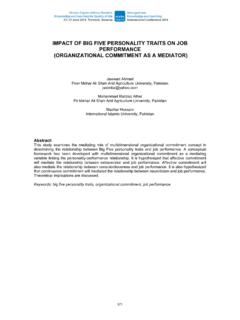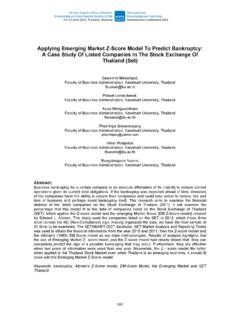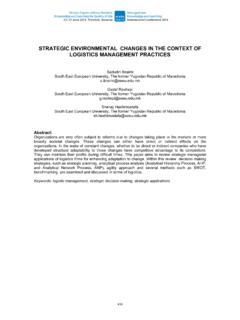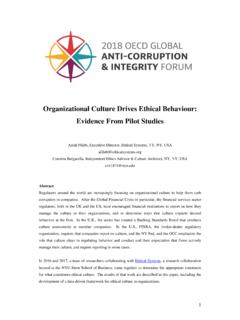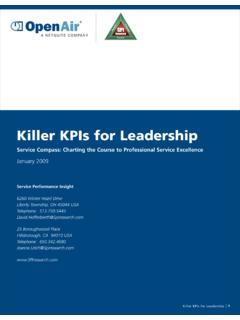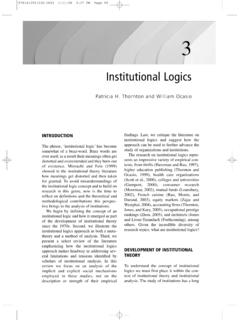Transcription of SAFETY CULTURE MODEL AND ITS DIMENSIONS ON THE …
1 SAFETY CULTURE MODEL AND ITS DIMENSIONS ON THE OF EXAMPLE OF THE COAL MINES IN POLAND Anna Rakowska Maria Curie-Sk odowska University, Poland Joanna Szubielska Abstract: In the article an original MODEL of SAFETY CULTURE and connected with it research results on the example of enterprises from the coal industry will be presented. Survey included 1170 miners. Thesis concerning that the key role in forming high SAFETY CULTURE is played by managers was verified. Keywords: organisational CULTURE , SAFETY CULTURE , leadership. 965 1. INTRODUCTION SAFETY CULTURE is not a completely new concept, and on a larger scale occurred in enterprises in the late 80 s. However, today due to the fact that on one hand organizations want to be well perceived on the market and search for methods to reduce costs and improve their quality of functioning, on the other hand external customers of enterprises put more emphasis on monitoring the activities of an organization as a result of which the issues connected with SAFETY CULTURE appear more frequently in many scientific studies and practical studies.
2 More and more companies discern the benefits from high SAFETY CULTURE (Zou, 2011, ). The approach towards SAFETY CULTURE has significantly changed in organizations. The aim of this article is to present an original MODEL of SAFETY CULTURE and it s verification in empirical studies which were carried out in coal mines in Poland on a sample of 1170 miners. Coal industry was chosen on purpose due to high risk potentially connected with performed work. 2. THE ESSENCE OF SAFETY CULTURE AND SCIENTIFIC APPROACH There are many definitions of SAFETY CULTURE in the literature. A thorough review of the SAFETY CULTURE concept is presented by Guldenmund in his book (2010a, pp. 11-15). The same author in his article (Guldenmund, 2010, pp. 1466-1478) pays attention to differences and similarities between the terms which are SAFETY CULTURE and SAFETY climate . It is assumed that SAFETY CULTURE derives from research current of the 80s concentrated around organization s CULTURE (E.)
3 Schein 1985, Ch. Handy 1976). Whereas to classics form the area of SAFETY CULTURE we can count such authors as Zohar (1980), Pidgedon (1991), or Geler (1994). SAFETY CULTURE in an enterprise reflects employees attitudes in scope of Health and SAFETY . An interest in SAFETY CULTURE and it s first definitions were formulated on the base of analysis of accidents, failures such as Chernobyl and Piper Alpha. Reports after these occurrences led to the conclusions, that low level of SAFETY CULTURE was the key element leading to the disaster. The SAFETY CULTURE concept plays critical role in used by people throughout the world, and explains everything which is connected with SAFETY , defeats and failures in this area. In the subject literature there is no one commonly accepted definition of SAFETY CULTURE . The definition of SAFETY CULTURE was formulated for the first time by International Nuclear SAFETY Group (INSAG) (the year) to emphasise the far from optimal conditions in the nuclear power plant in Chernobyl, this term has gradually embedded in the standards explaining SAFETY .
4 A conclusion results from the literature overview that SAFETY CULTURE is non-united concept according to research assumptions. Some of the models emphasise the development of observable indicators of SAFETY CULTURE , whilst others concentrate more on identification of basic assumptions of SAFETY CULTURE which are created on the base of group and by this group accepted, and lead to safe and efficient action. We can distinguish three approaches concerning it s understanding (Guldenmund 2010, pp. 1466 1470). The first one is that SAFETY CULTURE is identified with behavioural manifestations connected with SAFETY . It is typical behavioural approach. Deal, Kennedy (1982) determines SAFETY CULTURE as A way in which we act here . Ostrom, Wilhemsen, Kaplan (1993) present the concept according to which organizational beliefs and attitudes, shown actions, policy and procedures have influence over the level of SAFETY .
5 Geller (1994) evaluates that in total SAFETY CULTURE (Total SAFETY CULTURE ) everyone feels responsible for SAFETY and shows that in everyday work. This is typical behavioural approach. For Westrum (2004) SAFETY CULTURE is an organizational MODEL of reacting to problems and chances which organization comes across. The second approach is connected only with the research of foundations, values typical for classical approach of study of organizational CULTURE . SAFETY CULTURE according to that approach presents Cox, Cox (1991) for whom SAFETY CULTURE illustrates as approaches beliefs perception and values which are shared by employees in relation to SAFETY . For Berends (1996) CULTURE is a collective programming of mind aimed at SAFETY of group of members of an organization. For Guldenmund (2000) these are the aspects of organizational CULTURE which influence over attitudes and behaviours connected with minimizing the risk.
6 Hale (2000) defines it as values, attitudes, ways of perceiving shared by a group influencing on defining by it the norms and values, which determine the way of reacting according to actions and risk reaction and risk control systems. For Richter, Koch (2004) these are commonly learned and shared meanings, experiences, interpretations connected with work and SAFETY partially expressed symbolically which orient peoples activities connected with risk, accidents and prevention. INSAG (1991) The International Nuclear SAFETY Group presents the notion of SAFETY CULTURE 966 which is a set of characteristics, attitudes underlying in organization as well as individuals, which decide how important priority is and how big attention is paid to nuclear SAFETY at the power plant INSAG (Guledman 2010, p. 1467). Third approach is complex consists of both deeper areas such as values or attitudes but is also connected with evaluation of effectiveness of connected with them activities.
7 An example of a complex attitude in forming the definition of organizational CULTURE is Pidgeon (Pidgeon 1994: Pidgeon, N. & O'Leary, M.,2000, pp13-15) for whom it is a set of beliefs, values, norms, attitudes, roles, social and technical practices which are connected with minimizing the exposure of employees, customers and other members of society to danger and threat. To ACSNI (1993) Advisory Committee on SAFETY of Nuclear Installations SAFETY CULTURE in organization is a creation composed of individual and group values, attitudes, competences and patterns of behaviours which determine engagement, style and organization s efficiency in the area of health and SAFETY management. Organizations which have a positive SAFETY CULTURE of work are characterised by communication based on mutual trust, perception of the importance of security, belief in the efficiency of used SAFETY measurements (Guledman 2010, p.)
8 1467). On the other hand, having regard to scientific approaches we can distinguish academic perspective (anthropological), analytical and pragmatic. The first one examines the CULTURE according to ethnographic approach and these are research of quality nature. Its aim is describing and understanding the CULTURE rather than evaluating. In analytical approach SAFETY CULTURE is usually examined by questionnaires of a survey, which are the main instrument of social and organizational psychologists studies. Two first approaches together include the whole range of scientific research of SAFETY CULTURE . Academic one focuses on cultural crux and on understanding of its meaning by watching the past. Whereas analytical one allows to describe the current signs of CULTURE and how different types of behaviours are perceived by existing groups of employees.
9 A description of academic approach provides the context for the answers gathered from analytical approach. The third approach that is pragmatic focuses on characteristics of organization which influence on high level of SAFETY . It refers to interaction of structure, CULTURE and management processes. Pragmatic studies specify in detail what organization should do in order to reach more developed level of SAFETY CULTURE , what processes should be realised and supported by accompanying structure. The effectiveness of forming the desired level of SAFETY CULTURE in enterprise is largely determined by reliable diagnosis on the base of which the changes are introduced and systematically monitored. Referring to previously stated definition of SAFETY CULTURE according to Health and SAFETY Executive (Horbury, Bottomley, 1997), the SAFETY CULTURE can be considered according to two planes of visible and hidden its signs.
10 Based on the literature synthesis we can see that the most frequent method of SAFETY CULTURE studies are questionnaires methods and additionally organizational documents analysis (numerical data among others: accidents, costs of damages, absences). Currently, on the advisory market as well as in studies we can find different questionnaire forms for work SAFETY CULTURE . In used models of SAFETY CULTURE some common areas can be seen. Of course, the branch and risk connected with it can contribute to the fact that some factors seem to be more important at SAFETY CULTURE studies than others. The most popular DIMENSIONS of SAFETY CULTURE are presented below. The pioneer among them is D. Zohar D. (1980), who printed in his questionnaire eight areas. These are: importance of occupational SAFETY and health trainings, attitudes of management towards SAFETY , promoting good results connected with SAFETY , risk level in workplace, influence of required work on SAFETY , status of employees of occupational SAFETY and health services, influence of actions connected with SAFETY on social status, importance of security committee in an organization).
